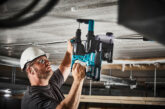
With requirements for surge protection increasingly on the agenda, we put the questions to Kirsty Johnson of Surge Protection Devices, to find out why site surveys are becoming more popular.
Q. How do you conduct a site survey? Is it in-person or remotely?
As a company, we’ve always offered site surveys for complex electrical installations, but during the pandemic, when we couldn’t travel, we also found that we can offer an excellent service remotely, which helps us get to site faster. There are some situations where an in-person site visit is still recommended, but for the majority of sites, a remote site visit is preferable.
Q. What type of situation would you recommend a company requests a site visit?
We can specify the surge protection required for the majority of sites with a simple phone call to our office, but sometimes site visits are recommended for complex electrical installations, usually where there will be multiple incomers, external lightning protection systems and installations where surge protection is being installed due to large amounts of previous damage.
Q. How does a site visit generally work?
Before arranging the appointment, whether in person or online, we will usually have an in-depth conversation with the electrician in charge. Many sites we can specify without the need to actually come to site, so this is where we will usually establish the need for the site visit. Once the need has been established, we will work with the electrician to decide which method of survey will be the most beneficial.
Once on-site, either in person or remotely, we’ll usually start the survey at the main incomer (or each main incomer individually, if it is a very large site) and assess the needs, while having discussions with the electrician regarding installation and location of devices. We’ll then proceed to look at sub distribution boards and finally specific equipment which may require individual protection. At this point we’ll have a discussion with the electrician to assess whether there are any additional things to consider for the installation, such as PV systems and EV chargers.
At the end of the visit, we’ll go away and produce a report with our findings and recommendations according to the latest regulations, which will be sent to the electrician as soon as possible.
Q. What tends to be the most common misunderstanding around the requirements for surge protection that you generally come across?
One of the most common misunderstandings is that surge protection can be installed at the main incomer to protect the entire installation. Surge protection needs to be considered for the main incomer and then every distribution board over 10 meters from the incomer, to provide protection for the installation. If there is an external lightning protection system installed, this is even more important. This will mean that every cable that enters or leaves the installation requires a type 1 SPD installed to meet the requirements outlined in BS EN 62305.
Q. Are you finding there are common themes with the types of recommendations you are making?
I’m finding that more thought is now being given to the protection of specific equipment pieces, such as fire alarms and data racks within installations. This is usually the sensitive equipment that is vital to the installation, in terms of safety and reliability.
Q. Give us an example of a recent visit you’ve conducted and how it went for all parties.
My only in-person site survey in recent times was an extremely complex site, with multiple incomers, back-up generators and external lightning protection systems.
The client had got in contact with us due to issues with a BMS panel that had been upgraded. Due to the majority of the electrical services being underground, a remote session wasn’t possible.
On visiting the site, it was quickly established that there were multiple external lightning protection systems, without adequate surge protection installed, but this was not what was causing the issues with the BMS systems.
On further discussions with the site engineers, I was told about the generator testing that happens regularly. It was my opinion that this was what was causing the damage to the BMS controls. It was discovered that the BMS systems had recently been upgraded, there were historically no issues with the old panels, but the generator testing did align with the damage that was seen on the newer panels. As the newer controls were more sensitive, the same overvoltage was now causing damage. A plan for the rollout of site wide surge protection was then put in to place to help overcome any future issues with upgrading technology.
If you’d like to discuss a potential site visit, please get in touch: kirsty@surgedevices.co.uk
To learn more about CPD training from Surge Protection Devices click here









